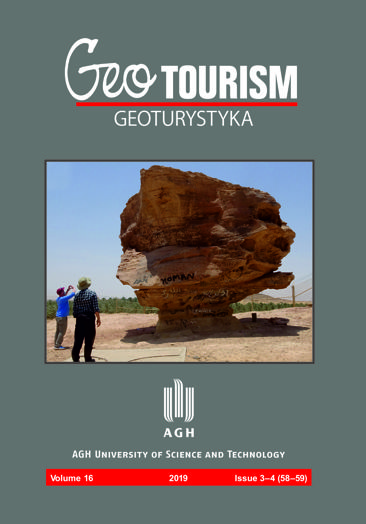The Paleozoic formations of the Al Qassim Province in Saudi Arabia as potential sites for geotourism
DOI:
https://doi.org/10.7494/geotour.2019.58-59.1Keywords:
geology, palaeontology, Paleozoic, geosites, Saudi ArabiaAbstract
The Paleozoic formations in the Middle East contain some of the world’s richest petroleum deposits, as they include excellent source and reservoir rocks. The Paleozoic rocks were deposited on the northern continental shelf of the Gondwanan continent at relatively high latitudes, and provide evidence of the Late Ordovician glacial event and associated sea-level changes. They also contain unique fossil remains. The Paleozoic formations exposed in the Al-Qassim province in Saudi Arabia are well-suited to become important sites for geotourism. Because the sedimentary formations are well-exposed and are easily accessible, they have strong capacity for development as tourist destinations. In this paper, we describe eight localities and their significance as potential educational sites for geology and palaeontology, as well as the archeological and economic significance of the Paleozoic formations of Saudi Arabia. The cultural and tourist infrastructure is summarised and a two-day field excursion is proposed.Downloads
References
Abbas M.A., Kaminski M.A. & Dogan A.U., 2017. Source, tectonic setting, and facies distribution of the Silurian Sharawra Formation, the Old Qusaiba Village, Central Saudi Arabia. Journal of African Earth Sciences, 130: 48-59.
Al-Laboun A.A., 1987. Unayzah Formation: A new Permian–Carboniferous unit in Saudi Arabia. American Association of Petroleum Geologists Bulletin, 71(1): 29–38.
Doktor M., Miśkiewicz K., Welc E.M. & Mayer W., 2015. Criteria of geotourism valorization specified for various recipients. Geotourism, 42–43: 25–38.
El-Khayal A.A. & Wagner R.H., 1985. Upper Permian stratigraphy and megafloras of Saudi Arabia: Palaeogeographic and climatic implications. In: Dixième Congrès International de Stratigraphic et de Géologie du Carbonifère, Madrid, 12–17 September, 1983, Compte Rendu, 3: 17–26.
Golonka J., 2012. Paleozoic paleoenvironment and paleolithofacies maps of Gondwana. AGH University of Science & Technology Press, Krakow.
Hayton S., Rees A.J. & Vecoli M., 2017. A punctuated late Ordovician and early Silurian deglaciation and transgression: Evidence from the subsurface of northern Saudi Arabia. American Association of Petroleum Geologists Bulletin, 101(6): 863–886.
Holcová K., 2002. Silurian and Devonian foraminifers and other acid-resistant microfossils from the Barrandian area. Acta Musei Nationalis Pragae, Series B, Historia Naturalis, 58(3–4): 83–140.
Kaminski M.A. & Perdana P., 2017. New Foraminifera from the Lower Silurian Qusaiba Shale Member of Saudi Arabia. Micropaleontology, 63(1), 59–66.
Kaminski M.A. & Perdana P.R.D., 2020. Lower Silurian benthic foraminifera from Saudi Arabia – including the oldest known multichambered lituolids. Stratigraphy, 17(3): 141–185.
Kaminski M.A., Perdana P., Abouelresh M.O. & Babalola L., 2019. Late Ordovician agglutinated foraminifera from the Ra’an Shale Member of Saudi Arabia as indicators of the O40 Maximum Flooding Surface. Stratigraphy, 16(1): 27–39.
Le Hérissé A., Vecoli M., Guidat C., Not F., Breuer P., Wellman C. & Steemans P., 2017. Middle Ordovician Acritarchs and problematic organic-walled microfossils from the Saq–Hanadir transitional beds in the QSIM-801 well, Saudi Arabia. Revue de Micropaléontologie, 60(3), 289–318.
Lemoigne Y., 1981. Flore mixte au Permian Supérieur en Arabi Saudite. Geobios, 14(5): 611–635.
Libertín M., Kvaček J. & Bek J., 2015. The oldest higher plants with in-situ spores from the Wenlock of the Bohemian Massif. In: Bubík M., Ciurej A. & Kaminski M.A. (eds.), 16th Czech – Slovak – Polish Palaeontological Conference and 10th Polish Micropalaeontological Workshop. Abstracts book and excursion guide, 56–57, “Grzybowski Foundation Special Publication”, 21.
Lüning S., Craig J., Loydell D.K., Štorch P. & Fitches B., 2000. Lower Silurian ‘hot shales’ in North Africa and Arabia: regional distribution and depositional model. Earth-Science Reviews, 49(1): 121–200.
Powers R.W., Ramirez L.F., Redmond C.D. & Elberg E.L., 1966. Geology of the Arabian Peninsula: Sedimentary Geology of Saudi Arabia. US Geological Survey Professional Paper, 560-D.
“Saudi Gazette”, 2018, Qusaiba: A window to Saudi geography, https://saudigazette.com.sa/article/527807 published on february 16, 2018, [accessed 2020.07.30].
Saudi Stratigraphic Committee, 2013. Phanerozoic stratigraphy of Saudi Arabia. Part 1 – Paleozoic successions of the Arabian Shelf (Cover Rocks). Saudi Stratigraphic Committee Special Publication SGS-SP-2012-1.
Seilacher A., 2000. Ordovician and Silurian arthrophycid ichnostratigraphy. In: Sola M.A. & Worsley D. (eds.), Geological exploration in Murzuq Basin. Elsevier Science, Amsterdam: 237–258.
Vaslet D., 1990. Upper Ordovician glacial deposits in Saudi Arabia. Episodes, 13(3): 147–161.
Vecoli M., Wellman C.H., Gerrienne P., Le Hérissé A. & Steemans P., 2017. Middle Ordovician cryptospores from the Saq-Hanadir transitional beds in the QSIM-801 well, Saudi Arabia. Revue de Micropaléontologie, 60(3): 319–331.
Williams P.L., Vaslet D., Johnson P.R., Berthiaux A., Le Strat P. & Fourniguet J., 1986. Geologic map of the Jabal Habashi quadrangle, sheet 26F, Kingdom of Saudi Arabia. Saudi Arabian Deputy Ministry for Mineral Resources Geoscience Map GM-98A, scale 1:250,000.
Zalasiewicz J., Williams M., Miller M., Page A. & Blackett E., 2007. Early Silurian (Llandovery) graptolites from central Saudi Arabia: First documented record of Telychian faunas from the Arabian Peninsula. GeoArabia, 12(4): 15–36.
Downloads
Published
Issue
Section
License
Copyright (c) 2020 Geotourism/Geoturystyka

This work is licensed under a Creative Commons Attribution 3.0 Unported License.

The content of the journal is freely available according to the Creative Commons License Attribution 4.0 International (CC BY 4.0).


